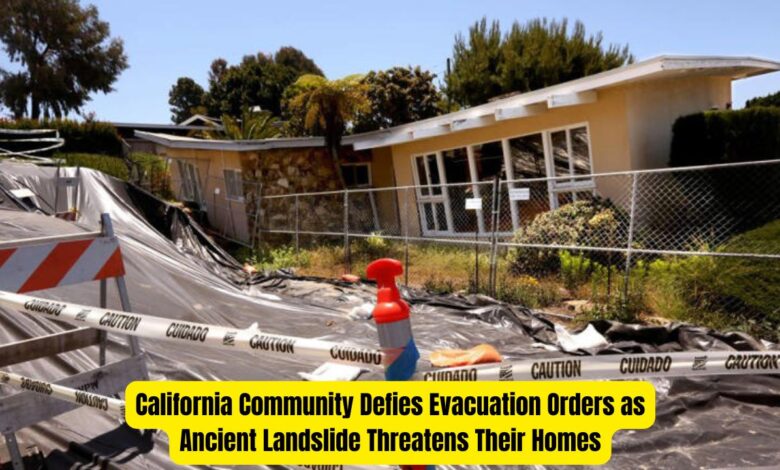California Community Defies Evacuation Orders as Ancient Landslide Threatens Their Homes

A California community is making headlines as they resist government-issued evacuation orders, despite the growing threat of an ancient landslide tearing their neighborhood apart. This defiance has drawn attention not only due to the looming natural disaster but also for the resilience and strong bond among residents. Understanding the underlying risks, motivations, and the sheer determination of these individuals sheds light on a crisis that could have far-reaching consequences.
What is Causing the Landslide in Southern California?
Southern California is no stranger to landslides, but this situation is unique due to the age and scale of the geological movements. The community in question sits on an ancient landslide, a relic of past tectonic activity. Over time, the earth in this region has slowly shifted, causing unstable ground and threatening infrastructure. Although this landslide is not sudden or explosive, its gradual creep has become a major concern for both geologists and the local government.
Several factors contribute to landslides in California. The state’s seismic activity, combined with heavy rainfall, weakens the soil and destabilizes hillsides. In this particular case, the ancient landslide zone has likely been reactivated due to a combination of drought-induced soil shrinkage followed by intense rainstorms, which is a common pattern in California’s Mediterranean climate. As a result, homes are being torn apart, leaving visible cracks in walls and foundations. Yet, the people who live there remain determined to stay put.
Community Resilience in the Face of Disaster
The people living in the affected areas have formed a tight-knit community. Many of them have lived there for decades, and their homes hold generational significance. Some residents argue that they’ve experienced minor shifts before without any major damage, and that this event is being overblown by authorities. They have built lives, families, and memories here, and the prospect of losing it all drives their resistance to evacuate.
“We’re not going anywhere,” one resident boldly stated, emphasizing their commitment to staying despite the growing risks. For many, the concept of leaving behind their homes is more frightening than the potential disaster. They have grown accustomed to the rhythm of California’s natural hazards—whether it be wildfires, earthquakes, or landslides. Each natural event is met with a community-wide effort to rebuild, making it hard for them to accept leaving their homes behind.
Evacuation Orders and Government Response
Local authorities have been issuing mandatory evacuation orders for those living in the path of the landslide. Despite the warnings, many homeowners have refused to leave, citing distrust in government warnings or a belief that their homes can withstand the creeping landslide. In response, officials are reinforcing the urgency of the situation, describing the risks as imminent and life-threatening.
Emergency services have been mobilized in the area to help those who may need assistance. Temporary shelters have been set up, and disaster relief teams are on standby. However, these efforts have only had limited success in convincing residents to leave. The government is also exploring legal options, as refusal to evacuate could complicate emergency response efforts.
Moreover, geologists are using advanced monitoring systems to track the movement of the ground. These systems have indicated a steady progression of the slide, and while the timeline is uncertain, experts are confident that without intervention, the situation will worsen. Public safety officials continue to emphasize that homes in the area are not structurally designed to withstand such earth movements and that staying poses significant risk.
The Financial Impact of a Potential Disaster
Should the landslide reach a critical point, the financial implications for homeowners and local authorities could be devastating. Many properties may become unsellable, and insurance coverage for landslide damage is often limited. The combination of loss of property value and the cost of rebuilding makes this an economically perilous situation for those affected.
The broader economy of the region could also suffer. A mass evacuation could lead to displacement that affects local businesses, schools, and infrastructure. With such a tight-knit community, the economic ripple effect could stretch far beyond the immediate area. The local government is already preparing for the costly logistics of potential recovery, even though many residents still believe their homes can endure the slow-moving disaster.
Why Residents are Refusing to Evacuate
At the core of the refusal to evacuate is a deep connection to the land and community. Many residents do not want to abandon their homes without a clear guarantee that the landslide will escalate to catastrophic levels. Skepticism over past evacuation orders that didn’t result in severe outcomes fuels their resistance.
For some, the landslide is seen as a manageable risk, one that does not warrant uprooting their lives. Several residents have been vocal about their desire for the government to focus on mitigation efforts like constructing retaining walls or reinforcing the ground, rather than evacuation. They feel that leaving would strip them of their right to decide the fate of their homes.
Additionally, moving out permanently or even temporarily presents major logistical and emotional challenges. Many families would face difficulties finding affordable housing elsewhere, and some elderly residents simply do not want to leave the only home they’ve ever known. This reluctance is further reinforced by a collective belief in their resilience—past natural disasters have come and gone, and they’ve always bounced back.
How This Situation Reflects Broader Challenges in Disaster Preparedness
The conflict between the California community and the authorities represents a larger issue in disaster preparedness across the United States. Communities often resist leaving their homes when faced with natural hazards, whether it be due to cultural ties, economic concerns, or skepticism of official warnings. In this case, the age-old problem of balancing individual rights with public safety comes into sharp focus.
Local governments must continually improve their strategies for communicating risk and providing clear, actionable plans that residents can trust. The situation also underscores the need for better infrastructure in hazard-prone areas and more investment in disaster mitigation efforts.
The refusal of this California community to evacuate shows the complex relationship between humans and their environment. As the climate continues to change, these kinds of natural disasters will only increase, making it crucial for residents and authorities alike to find better ways to collaborate and address these threats.




